Yves GARY Affichages : 3624
Catégorie : INDEPENDENCE
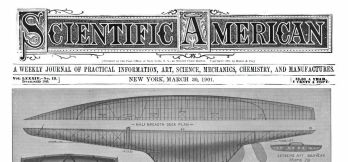 From the SCIENTIFIC AMERICAN (March 30, 1901) - Pas de traduction
From the SCIENTIFIC AMERICAN (March 30, 1901) - Pas de traductionThe very liberal policy which is being pursued by Mr. Thomas W. Lawson, the owner, and Mr. B. B. Crowninshield, the designer, of the 90-foot racing yacht, which is now under construction in Boston, for the defense of the America Cup, comes in pleasing contrast to the secrecy which of late years has surrounded ...
... the design and construction of challenging and defending yachts on their respective sides of the water. The illustrations of the Independence on the front page of this issue are made from photographs taken in the shed where the yacht is being built, and from the working drawings, blue prints of which were kindly furnished from the designer's office.
 The dimension of the boat are as follows : Length over all, 140 feet 10 ½ inches ; length on water line, 90 feet ; overhang forward, 27 feet 5 ½ inches ; overhang aft, 23 feet 5 inches ; beam, extreme, 23 feet 11 ½ inches ; beam at water line, 23 feet 5 inches ; draft, extreme, 20 feet ; freeboard at stemhead, 6 feet 11 inches ; freeboard at taffrail, 4 feet 8 inches : freeboard, least, 4 feet ; deck beam at forward end of water line, 15 feet ; deck beam at after end of water line, 18 feet 9 inches ; beam at taffrail, 11 feet 8 inches ; area of lateral plane, 772.6 feet ; area of midship section, 117.9 feet ; area of L. W. L. plane, 1,771.5 feet ; wetted surface, with small rudder, 2,913.5 feet ; with large rudder, 2,956 feet ; displacement, 146.76 tons.
The dimension of the boat are as follows : Length over all, 140 feet 10 ½ inches ; length on water line, 90 feet ; overhang forward, 27 feet 5 ½ inches ; overhang aft, 23 feet 5 inches ; beam, extreme, 23 feet 11 ½ inches ; beam at water line, 23 feet 5 inches ; draft, extreme, 20 feet ; freeboard at stemhead, 6 feet 11 inches ; freeboard at taffrail, 4 feet 8 inches : freeboard, least, 4 feet ; deck beam at forward end of water line, 15 feet ; deck beam at after end of water line, 18 feet 9 inches ; beam at taffrail, 11 feet 8 inches ; area of lateral plane, 772.6 feet ; area of midship section, 117.9 feet ; area of L. W. L. plane, 1,771.5 feet ; wetted surface, with small rudder, 2,913.5 feet ; with large rudder, 2,956 feet ; displacement, 146.76 tons.
Assuming that the new defender which Herreshoff is building will be an improved Columbia, as Columbia was an improved Defender, it is interesting, with the plans of the Lawson boat before us, to compare the points of difference between Independence and Columbia.
- In the first place, comparing the midship section, the Independence has a harder bilge, a flatter floor and the curve at the garboards is of much smaller radius ; in these respects, indeed, she is not unlike the Shamrock. As we leave the midship section, the difference between Independence and Columbia becomes very marked. In the Columbia the bilges begin to ease away rapidly toward the bow until at the forward end of the water line the cross section of the bow approximates a blunt V form, thus giving a sharp and easy entrance and water lines that do not lengthen much as the boat heels to a breeze. 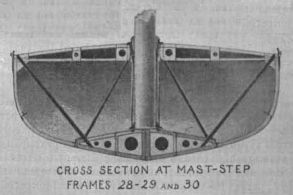 - Aft of the midship section the run and quarters of the Columbia are remarkably fine and easy, and although in a breeze she lengthens her water line almost to the taffrail , the form is such that there is but little perceptible drag, or quartering wave, when the vessel is reaching in a strong breeze. The characteristics of Independence are her extremely long overhangs, giving her an overall length fully 10 feet greater than that of any previous cup defender. Coupled with this great length is the fact that she carries her hard bilges and flat floor well out beyond the normal 90-foot mark, both forward and aft, thus providing an extremely long, flat floor and a great gain in water-line length when the boat is heeled. With this form of hull it is possible to carry a maximum amount of sail with a minimum amount of ballast, and as a matter of fact Independence will carry only 75 tons of lead in her keel as against the 85 to 90 tons which are generally credited to the Defender and Columbia.
- Aft of the midship section the run and quarters of the Columbia are remarkably fine and easy, and although in a breeze she lengthens her water line almost to the taffrail , the form is such that there is but little perceptible drag, or quartering wave, when the vessel is reaching in a strong breeze. The characteristics of Independence are her extremely long overhangs, giving her an overall length fully 10 feet greater than that of any previous cup defender. Coupled with this great length is the fact that she carries her hard bilges and flat floor well out beyond the normal 90-foot mark, both forward and aft, thus providing an extremely long, flat floor and a great gain in water-line length when the boat is heeled. With this form of hull it is possible to carry a maximum amount of sail with a minimum amount of ballast, and as a matter of fact Independence will carry only 75 tons of lead in her keel as against the 85 to 90 tons which are generally credited to the Defender and Columbia.
 Perhaps the best idea of the full bow and stern sections and natural sail-carrying power of the yacht is derived from a consideration of the load-water-line plane as shown on the accompanying plan, and the photographic view s of the interior of the hull looking toward the bow and toward the stern from the mast-step. Here it will be seen how the flat floor extends practically the whole length of the yacht, the hard curves at the bilges being maintained well into the bow, and carried out to the 79th or last frame,
Perhaps the best idea of the full bow and stern sections and natural sail-carrying power of the yacht is derived from a consideration of the load-water-line plane as shown on the accompanying plan, and the photographic view s of the interior of the hull looking toward the bow and toward the stern from the mast-step. Here it will be seen how the flat floor extends practically the whole length of the yacht, the hard curves at the bilges being maintained well into the bow, and carried out to the 79th or last frame, 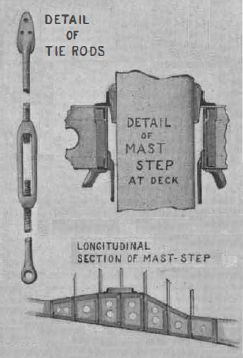 as shown in the cross-section of the hull at this point. Although there will be a certain bluffness in the bows it must be admitted that once entrance has been made, the lines of the yacht will be such as not merely to provide great sail-carrying power, but a form which will lend itself to high speed. Even when driven to the limit, the Independence should leave a wonderfully smooth wake behind her. It will be noticed that two rudders are provided; the after rudder will be used in place of the forward one, if the sailing trials prove that its more powerful control is necessary.
as shown in the cross-section of the hull at this point. Although there will be a certain bluffness in the bows it must be admitted that once entrance has been made, the lines of the yacht will be such as not merely to provide great sail-carrying power, but a form which will lend itself to high speed. Even when driven to the limit, the Independence should leave a wonderfully smooth wake behind her. It will be noticed that two rudders are provided; the after rudder will be used in place of the forward one, if the sailing trials prove that its more powerful control is necessary.
Considered from a structural standpoint, the new yacht shows how the principles of framed structures, as used by the engineer in bridge building, are being applied to yacht construction. The peculiar model of Independence, with her great overhangs and shallow depth, renders the task of meeting and distributing the intense local strains which are set up in the structure of such an extreme racing yacht most difficult. For instance, it will be noticed that the mast is stepped fully 10 feet forward of the stem and at a point where the molded depth of the boat is not more than 4 feet and the draft 2 feet. Upon the thin bronze bottom of the boat, which at this point is less than ¼ of an inch in thickness, is to be carried the enormous vertical load of the mast with its towering structure of spars, canvas and rigging, a load which is intensified by many tons when the vessel is heeled to a breeze, and the vertical component of the pull of the shrouds is added to the normal dead-load of the mast. This vertical thrust is met by interposing between the heel of the mast and the plating of the hull a deep, cellular structure of steel plates, which measures 12 feet in width by 14 feet in length, and is 2 ½ feet deep at the center. This structure is riveted upon the frail floor of the boat, and serves to distribute the load of the mast throughout the surrounding framework of the hull.
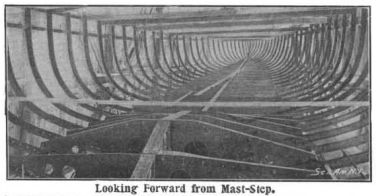 Associated with the mast foundation is a series of four, special, transverse, deck-beams, extending across the deck in the wake of the mast, which are in reality bowstring trusses, 17 inches in depth at the center, of great vertical stiffness. From the bottom of these trusses a number of ⅞ inch steel tie rods are carried down through the steel ring which forms the step of the mast and secured by knots below the bottom face of the same, thereby transmitting a portion of the mast load directly to these deck beams. Moreover, it will be seen from the transverse section of the boat at the mast-step that the special deck beams above mentioned and the mast-step framing are connected by a system of trussing, composed of 2 ⅜ inch hollow steel struts and 3 by 3-inch angles. As the transverse strains which are set up at this point in a racing yacht when she is being pressed to the utmost in a strong breeze are enormous, not only is there the great downward thrust of the mast as above explained, but there is the upward pull of the shrouds on the side of the boat which in itself will run up to the total of a great many tons. The deep deck beams and the cellular structure of the mast step, with the triangular bracing of the angles and struts, together constitute a true bridge structure, admirably adapted to take care of the intensified local stresses at this point, and distribute them over a broad area of the delicate shell of the yacht.
Associated with the mast foundation is a series of four, special, transverse, deck-beams, extending across the deck in the wake of the mast, which are in reality bowstring trusses, 17 inches in depth at the center, of great vertical stiffness. From the bottom of these trusses a number of ⅞ inch steel tie rods are carried down through the steel ring which forms the step of the mast and secured by knots below the bottom face of the same, thereby transmitting a portion of the mast load directly to these deck beams. Moreover, it will be seen from the transverse section of the boat at the mast-step that the special deck beams above mentioned and the mast-step framing are connected by a system of trussing, composed of 2 ⅜ inch hollow steel struts and 3 by 3-inch angles. As the transverse strains which are set up at this point in a racing yacht when she is being pressed to the utmost in a strong breeze are enormous, not only is there the great downward thrust of the mast as above explained, but there is the upward pull of the shrouds on the side of the boat which in itself will run up to the total of a great many tons. The deep deck beams and the cellular structure of the mast step, with the triangular bracing of the angles and struts, together constitute a true bridge structure, admirably adapted to take care of the intensified local stresses at this point, and distribute them over a broad area of the delicate shell of the yacht.

 Another interesting study is the provision made for giving the necessary longitudinal strength to the long, overhanging bow and stern of Independence. It will be noticed that there is a deep, vertical keel-plate which varies from a depth of 9 inches at the bow to 18 inches at the point where the fin keel commences. At the center line of the deck there is also a horizontal steel plate of the average width of 18 inches associated with the vertical plate which is from 6 to 8 inches in depth. Between these two members, which might be called the top and bottom chords, there is worked in a system of tie-rod bracing and vertical, hollow, steel struts, the rods varying from ⅞ of an inch to one inch in diameter and the struts from 1 ½ inches to 2 inches in diameter.
Another interesting study is the provision made for giving the necessary longitudinal strength to the long, overhanging bow and stern of Independence. It will be noticed that there is a deep, vertical keel-plate which varies from a depth of 9 inches at the bow to 18 inches at the point where the fin keel commences. At the center line of the deck there is also a horizontal steel plate of the average width of 18 inches associated with the vertical plate which is from 6 to 8 inches in depth. Between these two members, which might be called the top and bottom chords, there is worked in a system of tie-rod bracing and vertical, hollow, steel struts, the rods varying from ⅞ of an inch to one inch in diameter and the struts from 1 ½ inches to 2 inches in diameter.
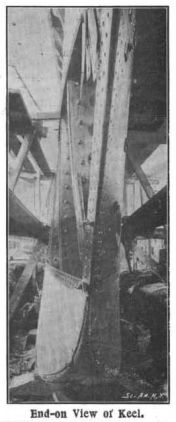 This construction provides what is practically a deep steel truss which extends from the stiffened framing at the mast out to the end of the overhanging bow. The necessity of trussing of this kind will be appreciated by those of us who remember what happened to the over lightly built bows of the 70-footers of last season, which, yielding to the enormous upward pull of the head stay and topmast stay, were drawn upward out of their proper line from 12 to 14 inches. The after overhang, it will be noticed, is similarly trussed, the tie-rod bracing, however, running only in one direction - being put in, doubtless, to assist in carrying the weight of the crew, when it is massed toward the taffrail to keep the bow of the boat up when she is running before the wind. The hull is further stiffened by four lines of stringers, two on each side, with 2-inch tubular struts, extending from the stringers to the deck beams.
This construction provides what is practically a deep steel truss which extends from the stiffened framing at the mast out to the end of the overhanging bow. The necessity of trussing of this kind will be appreciated by those of us who remember what happened to the over lightly built bows of the 70-footers of last season, which, yielding to the enormous upward pull of the head stay and topmast stay, were drawn upward out of their proper line from 12 to 14 inches. The after overhang, it will be noticed, is similarly trussed, the tie-rod bracing, however, running only in one direction - being put in, doubtless, to assist in carrying the weight of the crew, when it is massed toward the taffrail to keep the bow of the boat up when she is running before the wind. The hull is further stiffened by four lines of stringers, two on each side, with 2-inch tubular struts, extending from the stringers to the deck beams.
 There are 79 frames in the yacht, spaced about 2 ½ feet apart. The frames consist of nickel-steel angle bulbs. The plating of the hull is of bronze from the keel to the sheer strake, which latter is of steel. From amidships to a little forward of the mast the sheer strake is 9-32 of an inch in thickness, while from forward of the mast to the bow it is 14 of an inch, and from amidships to the stern it is 14 and 3-16 of an inch in thickness. From the garboard strake to the sheer strake the bronze plating is 7-32 of an inch and ¼ of an inch in thickness amidships and 3-16 of an inch thick forward and aft. From the garboard strake to the bottom of the keel the bronze plating is 14 of an inch and 5-16 of an inch in thickness, while the bottom plate of the keel is a bronze casting ⅝ of an inch in thickness. In constructing the yacht the keel was first built up and riveted, and then pig lead, with shot to fill up the interstices, was stowed, until 62 tons of the same was in place. Molten lead was then run over the top, to form a crust, and keep it in place. After the yacht is afloat, about 13 tons of pig lead will be stowed above this until the vessel has reached the desired trim. The deck beams are angle bulbs of the same weight as the frames. The deck plating is of steel and aluminium, distributed as follows : Continuous steel side stringers run from stem to stern, and vary in diameter from 3-16 by 10 inches at the ends, to ¼ inch by 2 feet in width amidships. There is also the longitudinal centerline steel plate, already referred to, which varies from ¼inch by 2 feet amidships to 3-16 of an inch by 1 foot in the ends.
There are 79 frames in the yacht, spaced about 2 ½ feet apart. The frames consist of nickel-steel angle bulbs. The plating of the hull is of bronze from the keel to the sheer strake, which latter is of steel. From amidships to a little forward of the mast the sheer strake is 9-32 of an inch in thickness, while from forward of the mast to the bow it is 14 of an inch, and from amidships to the stern it is 14 and 3-16 of an inch in thickness. From the garboard strake to the sheer strake the bronze plating is 7-32 of an inch and ¼ of an inch in thickness amidships and 3-16 of an inch thick forward and aft. From the garboard strake to the bottom of the keel the bronze plating is 14 of an inch and 5-16 of an inch in thickness, while the bottom plate of the keel is a bronze casting ⅝ of an inch in thickness. In constructing the yacht the keel was first built up and riveted, and then pig lead, with shot to fill up the interstices, was stowed, until 62 tons of the same was in place. Molten lead was then run over the top, to form a crust, and keep it in place. After the yacht is afloat, about 13 tons of pig lead will be stowed above this until the vessel has reached the desired trim. The deck beams are angle bulbs of the same weight as the frames. The deck plating is of steel and aluminium, distributed as follows : Continuous steel side stringers run from stem to stern, and vary in diameter from 3-16 by 10 inches at the ends, to ¼ inch by 2 feet in width amidships. There is also the longitudinal centerline steel plate, already referred to, which varies from ¼inch by 2 feet amidships to 3-16 of an inch by 1 foot in the ends.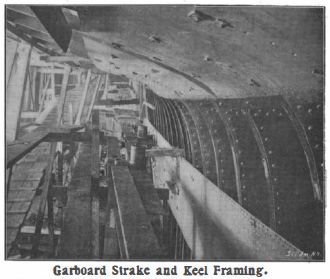 The deck is covered with 3-16 of an inch steel plating for a distance of 10 feet forward and aft of the mast. The rest of the deck is plated with aluminium. As the displacement of Independence is given as 146 ¼ tons and the total lead ballast will amount to about 75 tons, it is fair to presume that the total weight of the hull, spars, rigging, sails, stores and crew, when the boat is down to her 90-foot water line, will be about 72 tons.
The deck is covered with 3-16 of an inch steel plating for a distance of 10 feet forward and aft of the mast. The rest of the deck is plated with aluminium. As the displacement of Independence is given as 146 ¼ tons and the total lead ballast will amount to about 75 tons, it is fair to presume that the total weight of the hull, spars, rigging, sails, stores and crew, when the boat is down to her 90-foot water line, will be about 72 tons.
There can be no question of the great originality and skill with which the construction of this interesting boat has been worked out. The peculiarity of her form, her great sail-carrying capacity, involve that she will be put to severer strains than any yacht of her size that has yet been launched; and we think that the designer is to be congratulated upon the success with which he has combined lightness and strength in producing a powerful form.
Had the Independence been built upon what might be called the commonly-accepted lines of a 90-footer, and had there been less originality shown in the design , there would not be the great public interest attending her trials against the Herreshoff boat which is now certain to be manifested.
